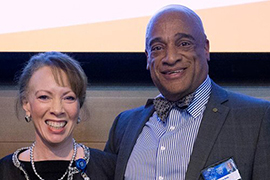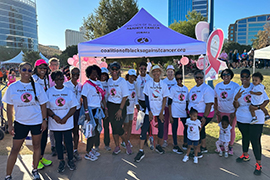- Slug: BC-CNS-Black Breast Camcer,1080 words.
- 3 handout photos available (thumbnails, captions below)
By Mia Milinovich
Cronkite News
PHOENIX – Cancer biology, inadequate insurance coverage and limited access to health care are a few factors influencing the consistently high breast cancer mortality rates for Black women in the United States, according to cancer experts. Black women are over 40% more likely to die from breast cancer than white women, a percentage that has largely stayed the same for a decade, according to the American Cancer Society.
While the overall disparity in deaths from many cancers has grown smaller between Black and white communities, there is a prevailing divide in mortality rates for breast and uterine cancers.
Arizona has high mortality rates for Black women with breast cancer and is ranked fifth-worst overall in the U.S. by KFF. According to the Arizona Department of Health Services, from 2016 to 2020, the rate of breast cancer deaths for Black women was 26.2 per 100,000 compared to 18.9 per 100,000 for white non-Hispanic women.
Dr. Michele Halyard, president and co-founder of the Coalition of Blacks Against Cancer and a professor emeritus of radiation oncology for Mayo Clinic, discussed the biological differences that contribute to this disparity.
“There is a more aggressive form of breast cancer called triple-negative breast cancer that is seen more commonly in Black patients,” Halyard said. “It has, without appropriate treatment, a lower survival rate, it’s more aggressive and it presents at an earlier age.”
The disparity in breast cancer mortality rates is also tied to limited access to health care in the Black community, according to Halyard. Gina Bowser, 67, was diagnosed in 1999 with stage 3 HER2-positive breast cancer, which the American Cancer Society says is present in approximately 15% to 20% of breast tumors.
Bowser said fear about the health care system kept her mother from seeking care for close to a year for what turned out to be breast cancer. Bowser learned about the importance of early screening after her mother died from stage 4 breast cancer.
“My mom did not have secondary insurance,” Bowser said. “She tried to ignore it and treat it on her own. We need the education to show people they don’t have to be afraid of getting the mammogram and talking to their family about what’s going on.”
On May 9, 2023, the U.S. Preventive Services Task Force posted its revised recommendation on breast cancer screening, lowering the age of initial screening from 50 to 40. This new recommendation states that to reduce their risk of death from the disease, women should begin mammography screenings at 40 years old and continue screening every other year until age 74.
The task force emphasizes that while screening is an important first step, it is not enough to improve inequities.
Dr. Wanda Nicholson, a member of the U.S. Preventive Services Task Force and senior associate dean of diversity, equity and inclusion at the Milken Institute School of Public Health, said there are crucial steps following screening and diagnosis.
“Black women do get mammography screenings, and they screen at rates very close to other women,” Nicholson said. “As a task force, we focus on screening, but screening alone is not enough. If someone’s screen is positive, then they need timely follow-up of that positive screening, and if biopsies are indicated, they need timely biopsies to be performed. Black women need access, ethical access, to the best treatments.”
To help combat this issue, the Coalition of Blacks Against Cancer hosts monthly support group sessions and provides attendees with accurate information to help guide them through their diagnoses.
Coalition member Penita Pratcher was diagnosed with triple-negative breast cancer in 2019 and underwent a nine-month-long treatment, including chemotherapy, surgery and radiation. Her involvement with the coalition began after a church member recommended she view their informational videos.
“That was useful for me. I even told some family members about it. There really is a need for this kind of community, particularly with Black women,” Pratcher said. “This is also a safe space with professionals who work in this field.”
The inspiration for the coalition was to address the disparity in treatment and mortality rates experienced by Black women. Co-founders Halyard and Marion Kelly, the administrative director and director of community and business relations for Mayo Clinic Arizona, formed the coalition in 2010 and have been operating the nonprofit as an educational resource since.
“We decided that we wanted to go to the community and understand what could we do to help Black breast cancer survivors be more informed about breast cancer, particularly the importance of screening, early diagnosis and treatment,” Halyard said. “We asked them what they wanted, and they said a focus on education and focus on support, and that’s how the Coalition of Blacks Against Breast Cancer was formed.”
The coalition has served as a safe space for many Black breast cancer survivors, including Pratcher and Bowser.
Upon receiving her diagnosis, Bowser decided to have both a mastectomy and hysterectomy, preventing her from having children. She has been a member of the Coalition of Blacks Against Breast Cancer since the beginning and has seen it adapt over time.
“I didn’t go to group meetings (at other organizations) when I was first diagnosed because no one there looked like me,” Bowser said. “With the coalition, doctors came in and educated us on so many things. African American doctors, oncologists, radiologists, nutritionists, you name it. For any questions we wanted to ask, there was no shame.”
High breast cancer mortality rates for Blacks have persisted in Arizona since 2016. The disparity has not yet been researched in depth, Nicholson said, contributing to the U.S. Preventive Services Task Force’s call for more specific analysis on the disparity.
When asked about the rates in Arizona, Halyard said there is a connection to health care barriers for many communities.
“The largest impact goes back to access to care, where you may have populations of people, whether they’re low income and or underrepresented, that don’t have that high-quality care,” Halyard said. “Within many areas of the country, access to specialists can be constricted or the wait times can be long.”
Nicholson said the next move nationally for addressing this issue starts with research, and from that research, an official recommendation can be made.
“Why are Black women at higher risk of having more aggressive cancers at a younger age?” Nicholson asked. “What might account for that? Is it environmental exposures? We need a better understanding of why it occurs, so we can move toward helping to prevent it.”
^__=
Coalition of Blacks Against Cancer co-founder Dr. Michele Halyard, left, and breast cancer survivor Penita Pratcher at an event, sponsored by Breast Believe, Phoenix Raceway and The Larry Fitzgerald Foundation, that offered free mammogram screenings on Nov. 2, 2023. (Photo courtesy of City of Avondale)
Dr. Michele Halyard, left, and Marion Kelly, co-founders of the Arizona nonprofit organization Coalition of Blacks Against Cancer. (Photo courtesy of Coalition of Blacks Against Cancer)
Members of the Coalition of Blacks Against Cancer at the Making Strides Against Breast Cancer of Phoenix walk on Oct. 28, 2023. (Photo by Christine Samuel/Coalition of Blacks Against Cancer)


